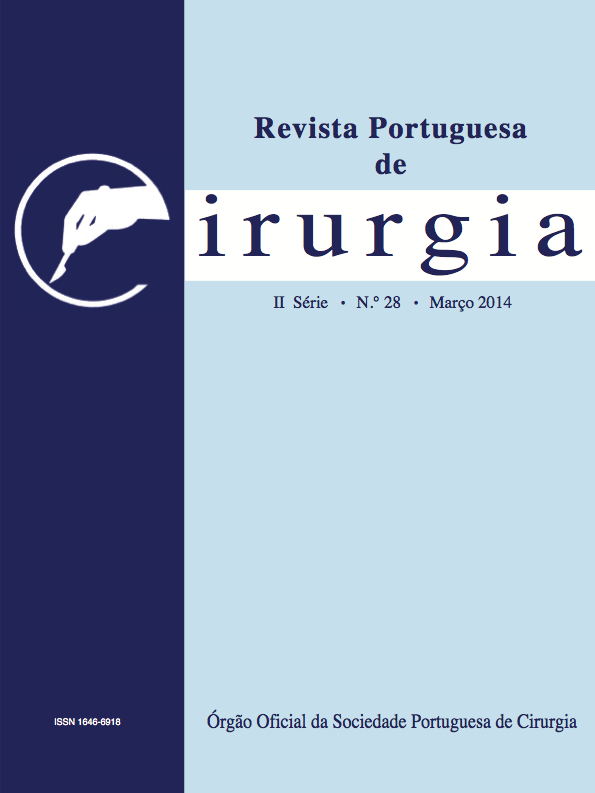Treatment of persistent perineal sinus after abdominoperineal resection with gracilis muscle flap
Abstract
Introduction: After an abdomino-perineal resection of the rectum, infection of the perineal wound is a complication observed in 7-47% of cases. Its incidence increases when associated to inflammatory bowel disease. Persistent sinus is observed in 3-69% of cases. There are various etiological factors associated with this complication; preoperative radiotherapy is the most important. There are various techniques using muscle flaps that can create conditions for closing the persistent perineal sinus. Gracilis muscle flap is a simple technique with good results.
Case report: Male, 66 years old, underwent radio and chemotherapy neoadjuvant followed by an abdomino-perineal resection in November 2007 due to an extraperitoneal rectal cancer involving the anal canal to dentate line. A postoperative infected seroma was noted, which was drained, resulting in persistent sinus. Operation to closure the sinus is below described.
Comments: Use of gracilis muscle flap is a good option for treat persistent perineal sinus. It can be accomplished by general surgeons with good results.
Keywords: abdomino-perineal excision of rectum, chronic perineal sinus, Gracilis muscle flap.
Downloads
References
Miles, W.E., A method of performing abdomino-perineal excision for carcinoma of the rectum and of the terminal portion of the pelvic colon (1908). CA Cancer J Clin, 1971. 21(6): p. 361-4.
Meyer, L., et al., Perineal wound closure after abdomino-perineal excision of the rectum. Tech Coloproctol, 2004. 8 Suppl 1: p. s230-4.
Ferrari, B.T. and L. DenBesten, The prevention and treatment of the persistent perineal sinus. World J Surg, 1980. 4(2): p. 167-72.
Lees, V. and W.G. Everett, Management of the chronic perineal sinus: not a problem to sit on. Ann R Coll Surg Engl, 1991. 73(1): p. 58-63.
Christian, C.K., et al., Risk factors for perineal wound complications following abdominoperineal resection. Dis Colon Rectum, 2005. 48(1): p. 43-8.
Manjoney, D.L., M.J. Koplewitz, and J.S. Abrams, Factors influencing perineal wound healing after proctectomy. Am J Surg, 1983. 145(1): p. 183-9.
Baird, W.L., et al., Management of perineal wounds following abdominoperineal resection with inferior gluteal flaps. Arch Surg, 1990. 125(11): p. 1486-9.
Wiatrek, R.L., J.S. Thomas, and H.T. Papaconstantinou, Perineal wound complications after abdominoperineal resection. Clin Colon Rectal Surg, 2008. 21(1): p. 76-85.
Ogilvie, J.W. and R. Ricciardi, Complications of perineal surgery. Clin Colon Rectal Surg, 2009. 22(1): p. 51-9.
Lohsiriwat, V., Persistent perineal sinus: incidence, pathogenesis, risk factors, and management. Surg Today, 2009. 39(3): p. 189-93.
Del Pino, A. and H. Abcarian, The difficult perineal wound. Surg Clin North Am, 1997. 77(1): p. 155-74.
Artioukh, D.Y., R.A. Smith, and K. Gokul, Risk factors for impaired healing of the perineal wound after abdominoperineal resection of rectum for carcinoma. Colorectal Dis, 2007. 9(4): p. 362-7.
Menon, A., et al., Pedicled flaps in the treatment of nonhealing perineal wounds. Colorectal Dis, 2005. 7(5): p. 441-4.
Goligher JD, D.H., Nixon HH, Surgery of the Anus, Rectum and Colon. 5o ed. 1984.
Anthony, J.P. and S.J. Mathes, The recalcitrant perineal wound after rectal extirpation. Applications of muscle flap closure. Arch Surg, 1990. 125(10): p. 1371-6; discussion 1376-7.
Fucini, C., et al., Quality of life among five-year survivors after treatment for very low rectal cancer with or without a permanent abdominal stoma.
Ann Surg Oncol, 2008. 15(4): p. 1099-106.
Petrie, N., et al., Reconstruction of the perineum following anorectal cancer excision. Int J Colorectal Dis, 2009. 24(1): p. 97-104.
Borel Rinkes, I.H. and T. Wiggers, Gracilis muscle flap in the treatment of persistent, infected pelvic necrosis. Eur J Surg, 1999. 165(4): p. 390-1.
Bernardi, C. and M. Pescatori, Reconstructive perineoplasty in the management of non-healing wounds after anorectal surgery. Tech Coloproctol,
5(1): p. 27-32.
Pemberton, J.H., How to treat the persistent perineal sinus after rectal excision. Colorectal Dis, 2003. 5(5): p. 486-9.
Galandiuk, S., et al., The use of tissue flaps as an adjunct to pelvic surgery. Am J Surg, 2005. 190(2): p. 186-90.
Kaminski, M., M. Sippel, and A. Hirner, [Persistent perineal sinus closure after rectal extirpation-an alternative using bulbocavernosus fat flaps].
Chirurg, 2004. 75(6): p. 627-30.
Downloads
Published
Issue
Section
License
Para permitir ao editor a disseminação do trabalho do(s) autor(es) na sua máxima extensão, o(s) autor(es) deverá(ão) assinar uma Declaração de Cedência dos Direitos de Propriedade (Copyright). O acordo de transferência, (Transfer Agreement), transfere a propriedade do artigo do(s) autor(es) para a Sociedade Portuguesa de Cirurgia.
Se o artigo contiver extractos (incluindo ilustrações) de, ou for baseado no todo ou em parte em outros trabalhos com copyright (incluindo, para evitar dúvidas, material de fontes online ou de intranet), o(s) autor(es) tem(êm) de obter, dos proprietários dos respectivos copyrights, autorização escrita para reprodução desses extractos do(s) artigo(s) em todos os territórios e edições e em todos os meios de expressão e línguas. Todas os formulários de autorização devem ser fornecidos aos editores quando da entrega do artigo.



